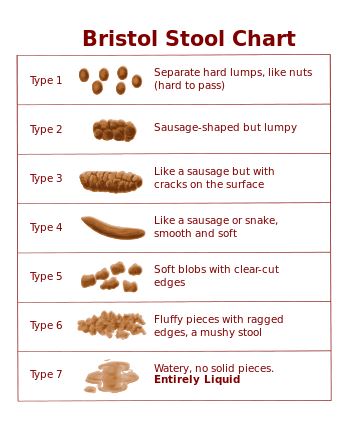The Bristol Stool Form Scale is a simple method of assessing how your digestive system is working. The scale is often used by GPs and medical experts to identify the time it takes for the things you eat to pass through your digestive system.
This is known as ‘intestinal transit time’. The shape and appearance of your stools is important because it can signify whether you are straining to go to the toilet or if your need to go is urgent. The scale consists of 7 types of stool, each described with text and an image.
Use a smartphone app to take the chart with you and keep an electronic record of your bowel movements day-to-day. Simply inspect your stool in the toilet before it is covered with toilet paper, make a mental note of which of the 7 types it is the most like, and then when you have finished in the toilet input your results.
Check out Poop happened smartphone app
The healthiest stool types are numbers 4 and 5, although the form will also be affected by what you have eaten in recent days. You may have seen a recent Department for Health campaign warning you to seek medical help if you detect blood in your stools or your stools have been looser than usual for more than three weeks. Both can be an indicator of more serious conditions and you should seek an expert opinion from your GP.
However, temporary changes can occur as your body adapts to your new fibre diet so if you are concerned and seek medical advice do tell them that you have been taking the Fibre Challenge.
Type 1: This stool indicates constipation and that the person is not able to completely empty their bowel. The lumps are hard, rough in texture and painful to pass. They are typically 1 to 2cm wide. There may also be bleeding. There isn’t likely to be any flatulence (wind).
Type 2: This stool indicates ‘organic’ constipation, which is the more serious type. The stool size is the same or bigger than the opening of the anal canal, so it’s going to cause extreme straining. It may also cause bleeding, piles or diverticulosis (pouches on the colon wall). There may be minor flatulence.
Type 3: This stool has the same characteristics as Type 2 stools, but the stools are quicker to get out, although straining is required. This stool type may indicate constipation that has not yet developed. There will probably be minor flatulence. The fact that it hasn’t become as enlarged as Type 2 suggests that bowel movements are regular.
Type 4: This is a normal stool. It is typical for people who open their bowels once a day. These people tend to eat a high fibre diet.
Type 5: These stools are considered to be normal as well. They are typical for a person who has bowel movements twice or three times a day, after meals.
Type 6: This stool type is considered as borderline normal. These kinds of stools may suggest a slightly hyperactive colon.
Type 7: This type of watery stool is classed as diarrhoea due to an infection or any other condition affecting the gut. It can also be a result of overflow after severe constipation. If you have any concerns about your bowel health, please consult your GP.
The Bristol Stool Form Scale was invented by Dr Ken Heaton, an expert in bowel function and nutrition. Now retired, Dr Heaton was a Reader in Medicine at the University of Bristol and Honorary Consultant Physician to the United Bristol Hospitals’ Trust. With permission from Dr Heaton, Norgine Limited and The Rome Foundation


Who’d have thought you could tell so much from poo! I’ll be keeping an eye out. Good info 🙂
Great to hear! It’s always good to keep note of these things. More tips to follow 🙂